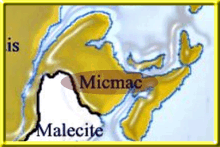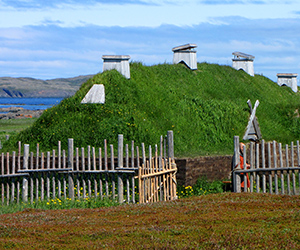CANADA HISTORY
Tsimshian

The Tsimshian people have a rich and complex history that dates back thousands of years. They are indigenous to the Pacific Northwest Coast of North America, and their traditional territory includes what is now the northern coast of British Columbia and southeast Alaska.
Before European contact, the Tsimshian lived in a complex society with a hierarchical political system, a highly developed art tradition, and a rich oral history. They were skilled fishers, hunters, and traders, and their economy was based on the abundant natural resources of their coastal environment, including salmon, halibut, and shellfish.
The Tsimshian were organized into several distinct tribes or clans, each with its own hereditary chief and council. They had a matrilineal social structure, with property and titles passed down through the maternal line. Their political and social systems were intertwined with their spiritual beliefs, which were based on a complex pantheon of gods, spirits, and supernatural beings.
The Indigenous peoples of the Pacific Northwest Coast, including the Tsimshian, are descendants of migrants who came to the region from Asia.
Studies of genetics, archaeology, and linguistics have provided evidence to support the theory that the first human inhabitants of the Pacific Northwest Coast descended from a population that lived in Asia. These migrants are thought to have made their way to the region thousands of years ago, traveling across a land bridge that once connected Asia and North America during the last ice age.
The Tsimshian society and culture was rich and complex, reflecting the unique environmental and historical conditions of the Pacific Northwest Coast.
The Tsimshian people were organized into several distinct tribes or clans, each with its own hereditary chief and council. They had a matrilineal social structure, with property and titles passed down through the maternal line. They were skilled fishers, hunters, and traders, and their economy was based on the abundant natural resources of their coastal environment, including salmon, halibut, and shellfish.
Tsimshian culture was deeply intertwined with spiritual beliefs and practices, which were based on a complex pantheon of gods, spirits, and supernatural beings. Their religious beliefs informed many aspects of daily life, including the practices of fishing, hunting, and trade, as well as the performance of various rituals and ceremonies.
Tsimshian art was also an important aspect of their culture, reflecting their spiritual beliefs and social values. Tsimshian artists were known for their intricate carvings, baskets, and textiles, which were used in religious ceremonies and everyday life. They also had a rich oral tradition, which was used to pass down stories, legends, and cultural knowledge from one generation to the next.
The Tsimshian society and culture was rich and complex, reflecting the unique environmental and historical conditions of the Pacific Northwest Coast.
The Tsimshian people were organized into several distinct tribes or clans, each with its own hereditary chief and council. They had a matrilineal social structure, with property and titles passed down through the maternal line. They were skilled fishers, hunters, and traders, and their economy was based on the abundant natural resources of their coastal environment, including salmon, halibut, and shellfish.
Tsimshian culture was deeply intertwined with spiritual beliefs and practices, which were based on a complex pantheon of gods, spirits, and supernatural beings. Their religious beliefs informed many aspects of daily life, including the practices of fishing, hunting, and trade, as well as the performance of various rituals and ceremonies.
Tsimshian art was also an important aspect of their culture, reflecting their spiritual beliefs and social values. Tsimshian artists were known for their intricate carvings, baskets, and textiles, which were used in religious ceremonies and everyday life. They also had a rich oral tradition, which was used to pass down stories, legends, and cultural knowledge from one generation to the next.
In summary, the Tsimshian society and culture was complex, reflecting the unique environmental, historical, and spiritual conditions of the Pacific Northwest Coast. Despite the many challenges they have faced since European contact, the Tsimshian people have maintained a strong cultural identity and continue to play an important role in the region's cultural and political landscape.
The religion of the Tsimshian people was based on a complex pantheon of gods, spirits, and supernatural beings. Their spiritual beliefs were deeply intertwined with their culture and daily lives, and played an important role in shaping their social and economic relationships.
Tsimshian spirituality was centered on a belief in a higher power, known as G'psgolox, and in a complex hierarchy of gods, spirits, and supernatural beings. These beings were believed to control various aspects of nature and to have the power to influence human affairs. The Tsimshian people practiced various rituals and ceremonies to honor these spirits and to ask for their guidance and protection.
One of the most important ceremonies in Tsimshian spirituality was the potlatch, a communal feast and gift-giving ceremony. The potlatch was used to mark important events, such as births, deaths, marriages, and the transfer of titles and property. It was also used to reinforce social relationships and to assert the status and wealth of the host.
Tsimshian spirituality was also reflected in their art, which often incorporated spiritual motifs and symbols. Carvings, masks, and other works of art were used in religious ceremonies, and played an important role in transmitting spiritual beliefs and cultural knowledge from one generation to the next.
In summary, the religion of the Tsimshian people was a complex and integral part of their culture, reflecting their beliefs in a higher power and in a hierarchy of gods, spirits, and supernatural beings. Their spiritual practices and beliefs informed many aspects of their daily lives, and played an important role in shaping their social and economic relationships.
The relationships between the Tsimshian people and other indigenous groups varied over time and were shaped by a variety of factors, including geography, economic interests, and political relationships.
In general, the Tsimshian people had good relationships with many neighboring indigenous groups, and engaged in a variety of trade and social relationships with them. For example, they traded with the Haida people to the north and the Tlingit people to the south, exchanging goods such as fish, furs, and slaves. They also intermarried with neighboring groups, which helped to strengthen social and political ties.
However, the Tsimshian people also had conflicts with some neighboring groups, particularly over resources and territory. For example, they fought with the Haida over control of certain fishing and hunting grounds, and with the Tlingit over access to trade routes.
Overall, the relationships between the Tsimshian people and other indigenous groups were complex and dynamic, shaped by a variety of factors, including economic interests, political relationships, and cultural differences. Despite the challenges they faced, the Tsimshian people were able to maintain a strong cultural identity and to play an important role in the region's cultural and political landscape.
Yes, the Tsimshian people, like many indigenous groups in the Pacific Northwest Coast region, had a practice of slavery. Slaves were individuals who were captured in war, traded, or inherited, and who were forced to work for their owners.
Slaves played a significant role in Tsimshian society, and were used for a variety of purposes, including labor on fishing and hunting expeditions, as well as in households and communities. They were also often used in potlatches, as a display of wealth and status, and as a way of redistributing resources within communities.
The treatment of slaves varied among the Tsimshian and other indigenous groups in the Pacific Northwest Coast region. In some cases, slaves were treated as members of the family, and were given opportunities to earn their freedom. In other cases, however, they were subjected to harsh treatment, including physical abuse and forced labor.
Slavery was eventually abolished by the Canadian government in the late 19th century, as part of a larger effort to assimilate indigenous peoples into Western society. The practice has since been condemned and is no longer practiced.
The first known contact between the Tsimshian people and Europeans occurred in the late 18th century, when European explorers and fur traders began to visit the Pacific Northwest Coast.
One of the first Europeans to make contact with the Tsimshian was Captain James Cook, who visited the coast in 1778. However, it was not until the late 18th and early 19th centuries that significant numbers of Europeans began to visit the region, seeking to trade furs and other resources with the indigenous peoples.
The Hudson's Bay Company, a British fur trading company, was one of the first Europeans to establish a presence in the region, opening a trading post at Fort Simpson on the Tsimshian's traditional territory in 1834. Other European fur trading companies, such as the North West Company, soon followed, and established trading posts throughout the Pacific Northwest Coast.
These early contacts had a significant impact on the Tsimshian people and their way of life. The trade relationships established with the Europeans brought new goods and technologies to the region, but also introduced new diseases and social and economic disruption. The Tsimshian people were also subjected to increasing pressure from the Canadian and American governments, who sought to assimilate them into Western society and to extract resources from their territory.
The arrival of European explorers, fur traders, and missionaries in the late 18th and early 19th centuries had a profound impact on the Tsimshian people. They suffered greatly from introduced diseases, such as smallpox, that decimated their population, and their traditional ways of life were disrupted by the arrival of new cultural and economic influences. Despite these challenges, the Tsimshian people have maintained a strong cultural identity and continue to play an important role in the region's cultural and political landscape.
1778: Captain James Cook becomes the first known European to make contact with the Tsimshian people.
Late 18th and early 19th centuries: European fur trading companies, such as the Hudson's Bay Company, establish trading posts in the Pacific Northwest Coast, including in the Tsimshian's traditional territory.
1834: The Hudson's Bay Company opens a trading post at Fort Simpson on the Tsimshian's traditional territory.
Late 19th century: The Canadian government begins to exert greater control over the Tsimshian and other indigenous peoples in the Pacific Northwest Coast, as part of a larger effort to assimilate them into Western society and extract resources from their territory.
1884: The Canadian government enacts the Indian Act, which imposes a system of Indian reserves and band councils on indigenous peoples, and restricts their cultural practices, including the potlatch.
Late 19th and early 20th centuries: The Canadian government begins a program of residential schools, aimed at assimilating indigenous children into Western culture.
1951: The Canadian government repeals the potlatch ban.
1987: The Gitxsan and Wet'suwet'en people launch a legal challenge to their traditional territories, arguing that they have never surrendered their lands to the Canadian government.
1997: The Supreme Court of Canada recognizes the existence of Aboriginal title and rights in the Delgamuukw case.
2007: The United Nations declares the year 2007 to be the International Year of Indigenous Languages, in recognition of the importance of preserving and revitalizing indigenous languages and cultures.
2021: The Tsimshian people, along with other indigenous groups in the Pacific Northwest Coast, continue to assert their cultural and political rights, and to work towards the recognition and protection of their traditional territories and resources.
Cite Article : www.canadahistory.com/sections/documents




